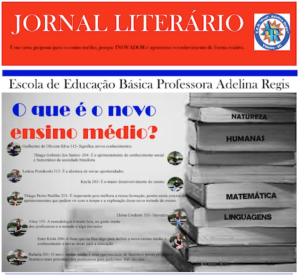News . Best Practices Language in the journalistic-media field and newspaper literature. (Best Practice Brazil)

This open scenario practice was carried out during the pandemic by teachers Graziela Amancio da Silva Kubiak, Lilian Camila Spinelli and Marta Maria Falchetti, respectively in the Portuguese, English and Spanish language disciplines, on the theme “Language in the journalistic-media field and newspaper literature”, at the School of Basic Education Professor Adelina Régis. Students interacted with social scientists, educational researchers, and the local community, including family members. It was supported by APC PUC-PR.
CARE: The students were involved in the discussion about the COVID-19 contingency plan. The participants were 96 students, aged between 14 and 16, from the 2nd grade of high school, 20 of whom completed the scientific action, along with their families, a teacher, a researcher, and a scientist who shared their concerns about COVID-19. All were involved in the objective of analysis and study actions on the problem of creating a school newspaper, based on media journalism for the dissemination of learning activities carried out during the 2021 school year, especially activities integrated by areas of knowledge, provided for the New High School and actions on COVID-19.
KNOW: Curricular activities were developed, in an interdisciplinary and transdisciplinary way, between the components of the area of Languages and their Technologies, with an emphasis on the scientific content of Portuguese, English and Spanish, especially in the analysis of the information collected and transformed into media language to be disseminated. in the school newspaper. The responsible decisions of those involved in curating the news to be edited and made public was an essential learning experience. The mastery of what journalistic-media texts is, questions about Science and Technologies, especially the topic of COVID-19, the difference and complementarity between written and visual language and the mastery of digital authoring tools such as Scribus and Adobe Fireworks digital resources anchored the learning in the teaching-learning process.
As skills to be developed in the learning processes, the student’s ability to have decision-making autonomy was addressed in the face of challenges in/of society; to be a subject in the construction of individual and collective knowledge; the resourcefulness of reading, orality and writing and the mastery of digital authoring tools.
Regarding attitudes, the focus was on identifying information and opinion as phenomena, fake news, and post-truth; the valorization of communication in the social and cultural context in the journalistic-media field, as well as improving the practices of curation, organization and dissemination of information to the public, in a critical and ethical way.
DO: Students were involved in the following activities:
- Presentation of videos and websites on the field of media-journalism, digital technological resources, and access to a diversity of scientific content.
- Reading of material available on the role of the media-journalism field in/of society.
- Investigation of forms of contemporary journalism and identifying the veracity of facts and identifying fake news, post-truth and its effects.
- Construction of the digital and printed newspaper with learning activities developed in the school environment covering several areas of knowledge.
- Elaboration and layout of the digital and printed literary newspaper covering what the New High School is and the learning activities that cover the different areas of knowledge that were carried out at the school during the 2021 school year;
- Printing and dissemination on the newspaper’s social networks for access by families, educational institutions, and the community in general.
FINDINGS: The open scenario methodology used was project-based collaborative learning. Adjustments to the school curriculum happened naturally during the learning process, given the needs and interests of students. Due to the teaching modality that the school offers in the New High School, which is based on the development of skills and abilities by areas of knowledge, it was possible to adjust the learning necessary for the development of the project. As the school offers teaching by areas of knowledge, it facilitated the planning of actions, the applicability of learning activities targeting technological resources and curricular interaction through projects.
OUTCOMES: The creation of the newspaper was a valuable idea as a motivation and appreciation for the students to feel themselves actors in the production of knowledge and subject to the curation of information to be published in a media. The students involved participated actively and responsibly in the creation of the newspaper. Always attentive and helpful in the orientation and collection of information based on media journalism. This activity motivated the students to have autonomy and mastery in the writing and layout of news through printed and digital language.
The sparkle in the eyes and the smile on the students’ faces when delivering the printed newspaper was proof that they were satisfied and confident in the work carried out.
The very social distancing caused by the pandemic caused many disruptions in the school routine, which contacted scientists, newspaper editors and even visits to a space for journalistic production impossible. A The return to face-to-face classes with 50% of the students, in a rotation way, reduced the time for carrying out the learning activities.
Find out more here: Our report.